Why is everyone talking about how IP rights & CC0 affects NFTs? Here’s the full breakdown.
Welp. Turns out spending $116K on a JPEG doesn’t actually mean you own it.
AWKWARD.
Look, If you hold an NFT in your wallet, of course you own the NFT, but that doesn’t mean you own the art *associated (linked) *to the NFT. In fact, out of the top 25 projects currently listed on OpenSea, only one even ATTEMPTS to give you legal ownership of the associated artwork.
ONE.
And it damn sure ain’t the Apes.
The IP vs CC0 Debate
The debate around how NFT collections handle IP rights is passionate, to say the least. Perhaps the most divisive hot take on the IP vs CC0 debate comes courtesy of nft42 founder J1mmy.eth who put it as “Capitalism v Communism”.
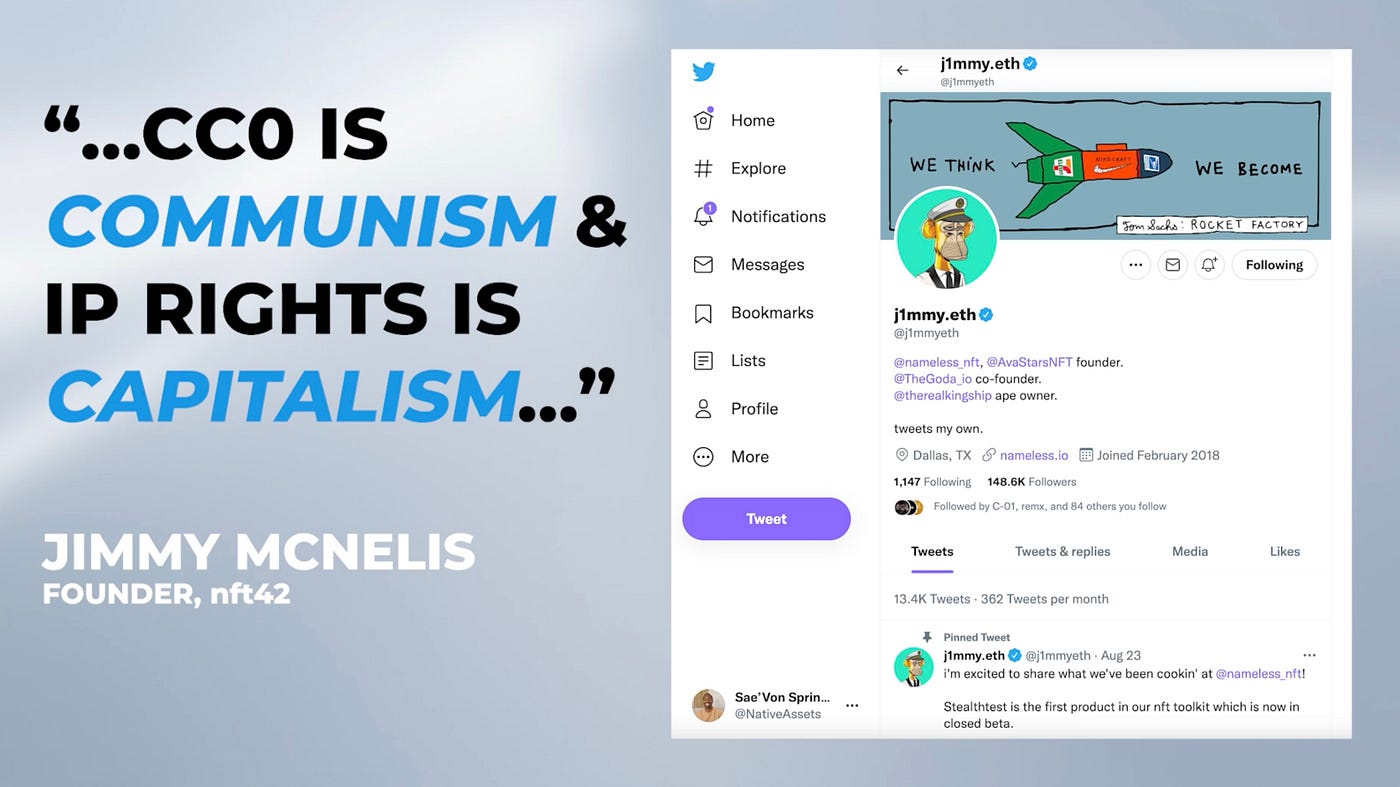
Given the difference in how each approach affects monetization potential, I can see where such a generalization holds some merit, but solely focusing on the monetary aspects is shortsighted when considering the varied nuances.
But why is this even relevant?
The NFT Ownership Misconception
For better or worse, one of the core narratives contributing to the meteoric rise of NFTs is the assumption that owning an NFT gives you ownership of whatever is linked or associated with it.. Though certainly a killer use case, it’s far from the only one. Since NFTs *CAN *grant ownership rights, and sometimes DO, even if in limited fashion -the purpose or value of holding an NFT that *doesn’t *grant IP rights gets confusing.
The recent okie-doke from the Moonbirds project, Tiffany’s creating Punks jewelry, & the BAYC/Ryder Rips lawsuit have each brought different IP rights issues to light, forcing the wider community to reassess the very essence & value of their NFTs. Ultimately one central question remains on everyone’s mind — WHO OWNS THE ART?
As sticky as that question may be — I THINK I’ve got the answer for you.
First, though — special thanks to Alex Modell, Max Curnin & Jeremy Goldman for breaking a ton of this stuff down in an interview with Carly Reilly on her show Overpriced JPEGS & to the team over at Galaxy.com for the phenomenal write up they’ve done on the topic. Their expertise made this a million times easier to put together.
Now, Let’s dive in.
What Is IP — An Overview
IP RIGHTS DEFINED
Intellectual Property is merely a catch-all term to describe property rights related to non-physical assets. Accordingly, there are four main types of Intellectual Property — Copyrights, Trademarks, Patents, & Trade Secrets. Given that Copyright is the primary legally recognized form of IP for digital content, we’ll focus our attention here. So note that whenever a project says you own the IP or have IP rights, Copyright is what they’re usually referring to.
Understanding Copyrights
A copyright covers expression that’s fixed in a tangible medium. — painting, art, photos, motion pictures, video games, etc. Copyright ownership grants the owner “the ability to exercise the exclusive rights…to authorize others to exercise any of those exclusive rights, and to prevent others from exercising any of those exclusive rights” More specifically it allows the Copyright holder the right to reproduce, distribute, publicly display, perform the work and to create derivative works. Hence, copy -right.
Source: Copyright Alliance
Thankfully, you don’t need to file anything to obtain a copyright for your works — it exists once you create the work, However if you need to enforce the protection of your copyright from infringement (AKA sue someone), you must file for a copyright registration. Otherwise, you can’t do much about it. Once granted, copyrights remain in effect for up to 70 years after the original author’s death — at which point the work is entered into the public domain as it transitions to a CC0 work, something we’ll touch on in just a second.
The IP Thesis — Control, Commercial Rights & Incentives
So, legal hurdles & constraints aside, what’s the beef between IP advocates & CC0 champions?
The core thesis for those supporting the standard of NFT IP rights is the assumption that such rights directly incentivize holders to contribute productive, thoughtful or creative applications to the underlying property, be it an Ape, Doodle, Bad Influence, or other work, since they hold exclusive rights to capture any value created in the process.
For example, BAYC owners licensing their NFTs to star in virtual bands, Boss Beauty’s signing to WME, or otherwise leveraging the NFT for commercial means.
Whether you plan to monetize your NFT or not, this article by Galaxy.com puts it best, noting “Without copyright, a purchaser of digital content does not own that content, but instead “licenses” that content from the copyright holder, on terms dictated by the copyright holder. In this sense, the copyright holder (i.e., the licensor) is the digital content landlord; the purchaser (i.e., the licensee) of that content is the digital content tenant.”
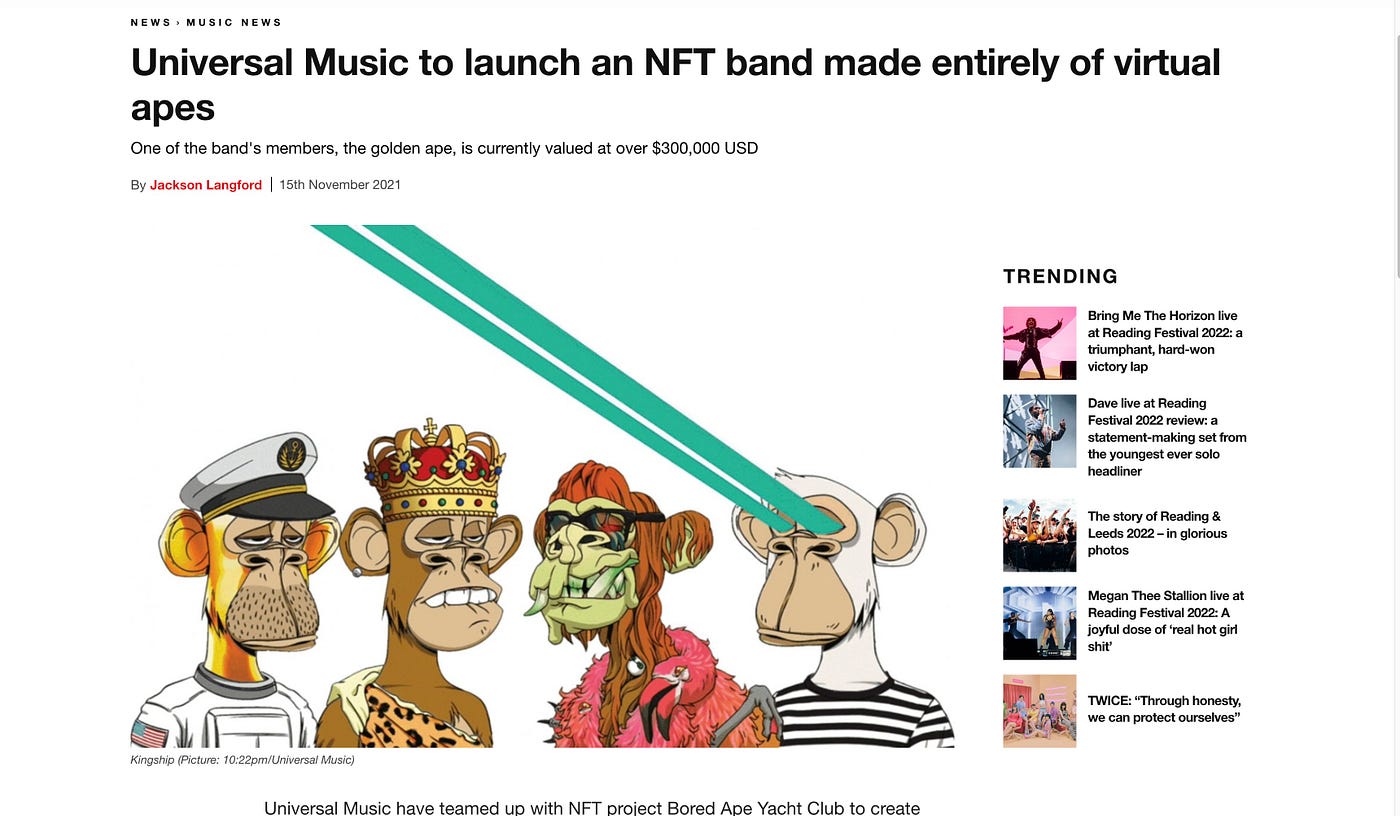
Universal Music Group (UMG) Signs 4 Bored Apes To New VIrtual Band “KingShip”.
Challenges With NFT Copyrights
Well, that seems pretty cut and dry, right? If a collection wants, can’t they just grant their holders IP rights? Not exactly.
Legal Transfer of Rights
Ensuring legal copyrights are transferred from the original author or artist to the projects’ creators, and then on to the holders themselves can be quite a process. According to 17 U.S.C. § 204(a) of the Copyright Act, a valid transfer of copyright must be in writing and be signed by or on behalf of the transferring party.
While it’s common for projects to make an announcement regarding IP rights in their discord, or via Twitter, that’s not a legally binding or enforceable transfer. Historically, such a transfer is executed via “IP Assignment Agreement” (see Larva Labs transfer to Yuga Labs), but there are some teams working on making this a more seamless, yet legally sound on-chain process like the folks at Remaster.IO. After you finish this video, be sure to check out our interview with their Co-Founders Max Curnin & Alex Modell if you want to learn more about what they’re doing & how it works.
Limited License Agreements
If we assume a legally binding full transfer of copyright ownership from the artist responsible for a collection’s art over to the creators or company behind the project, the project can now bestow full copyrights to the holders.
But — they probably won’t.
Instead, what most projects do is issue what’s known as a copyright license, a LIMITED license, specifically. This limited license ensures that the collection retains full copyright ownership, thus affording them continued use of all associated art or other IP however they like.
Though a finesse at first glance, there are some benefits to this limited approach. If as a holder you want Yuga Labs or whatever project you’re involved in to keep building out the ecosystems surrounding the collection, they have to keep the rights.
Otherwise, they would have to check with every holder before using their NFT’s artwork in ads, merch, or even to create models within a virtual world like Otherside.
Revocability
Another major shortcoming of limited licensing is its revocability. Unless a copyright is transferred in whole without limitations, the original copyright owner can revoke your license at any time for any reason, without notice. Just ask Moonbirds holders. If you happen to work a licensing deal allowing a brand or business to use the artwork associated with your NFT, but then YOUR rights are revoked- what does it mean for that deal?
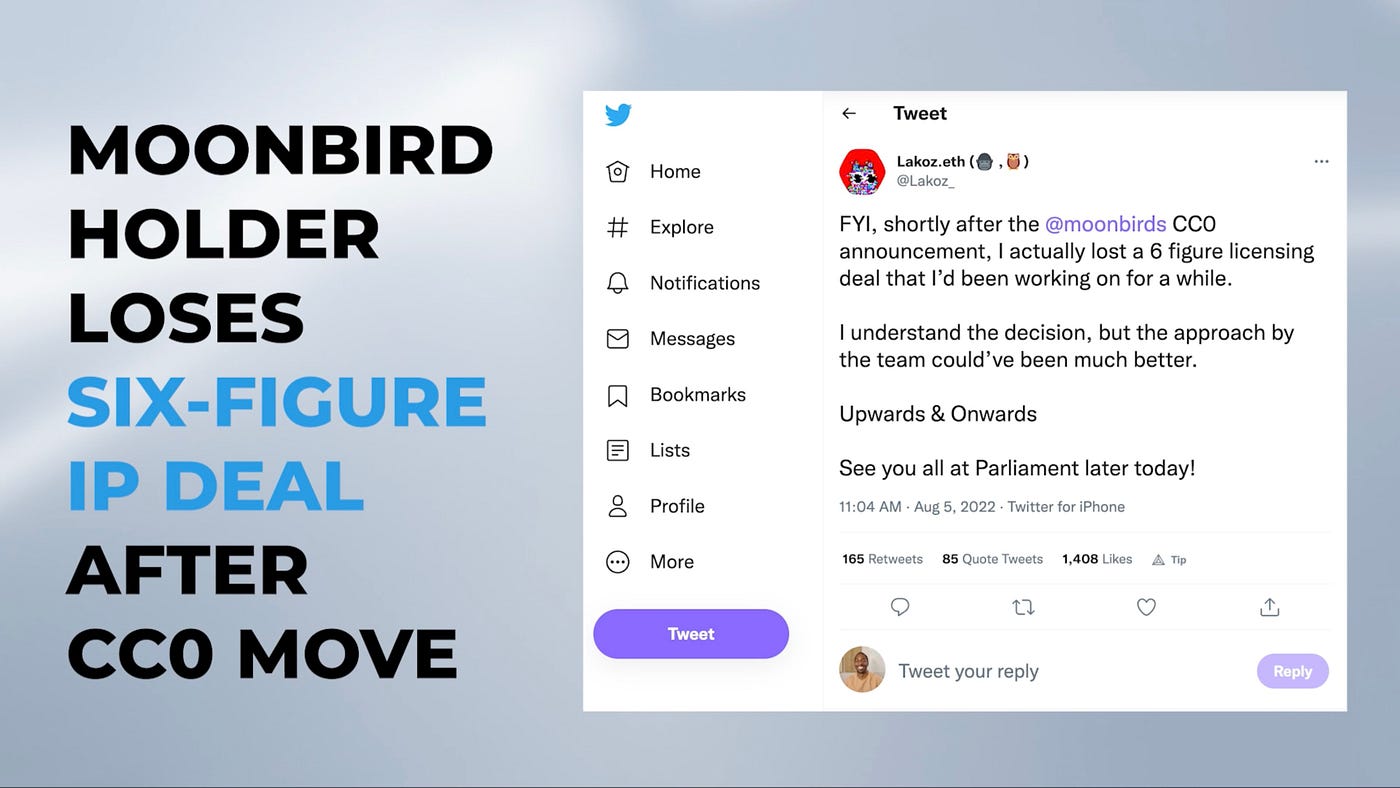
Restricted Terms & Limitations
Even if a project claims to grant copyrights to you & never revokes those rights, you should pour through the terms of service & agreements to find out what rights are spelled out in the letter of the law. This due diligence is the only way to find out what sort of rights you have. The research team at Galaxy reviewed dozens of collections and found that most projects’ terms grant holders 1 of 4 types of limited licenses.
**Commercial Rights **You can monetize the artwork freely — no cap on revenue, in any venue or format, for any length of time. (See Azuki)
**Limited Commercial Rights **You can monetize the artwork up to a certain amount of revenue, or in limited formats or venues, or for specified periods of time. Often, this license applies only to low-dollar sales ($100k limit) of merchandise (i.e., t-shirts). (See Doodles)
**Personal Use Only **You cannot monetize the artwork in any respect. You have limited display rights. (See VeeFriends)
**Creative Commons **The artwork is placed in the public domain. (See Moonbirds)
As of this moment, World of Women is the only collection within the top 25 NFT projects (based on implied market cap) that has explicitly stated their intent to assign full copyrights to their holders directly within a dedicated IP Assignment Agreement.
No matter how you slice it — this IP rights stuff can get messy. If only there was a simpler way!
Enter CC0.
What Is CC0 — An Overview
CC0 DEFINED
According to NFTNow, “CC0, also known as the Creative Commons, means ‘no rights reserved’ on intellectual property. It’s a form of copyright that allows creators to waive legal interest in their work and move it into the public domain as far as possible.”
Unlike term bound, “don’t do this’ ‘, “can’t do that” limited copyright licenses, CC0 licenses have zero restrictions & are irrevocable once granted. When a project goes CC0, there’s no going back. The finality of this license alone is a benefit.
The CC0 Thesis — Collective Ownership & Cultural Penetration
Given the challenges & complexities with limited copyrights, many deem CC0 as the simplest, most permissive license available. By “open sourcing” the artwork to allow anyone to use it as they see fit, be it for commercial use, derivative collections, or any other means — the dominant supporting thesis predicts that it’s far easier for a project to gain significant cultural penetration.
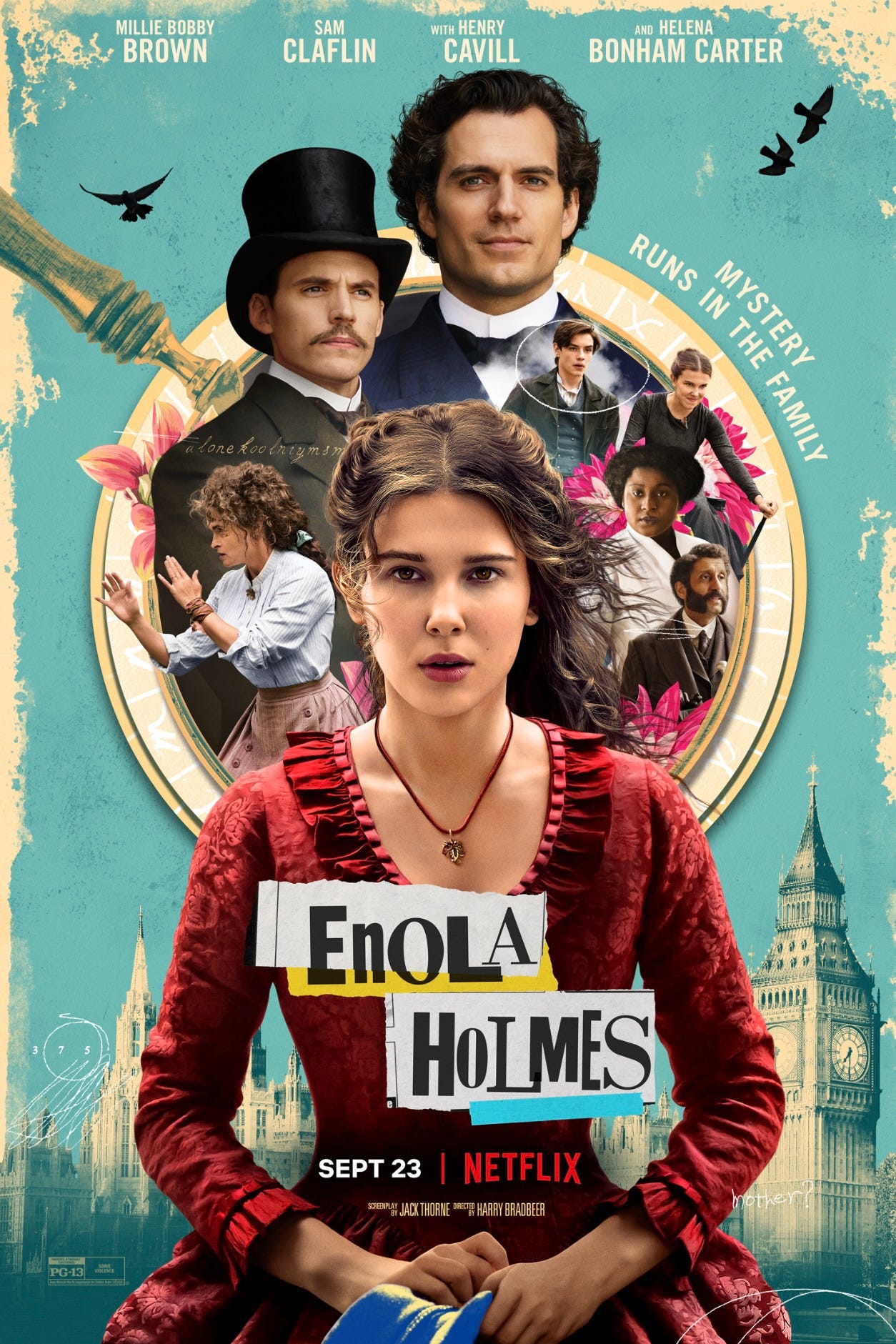
Sherlock Holmes is often cited as demonstrating the power of public domain works, exploding in mindshare over the past 2 decades from multiple takes on the source material, including the BBC show & the Rober Downey Jr. films. Even El stopped the nose bleeds & remote viewing long enough to join in the investigative shenanigans! With so many distinct interpretations flooding the collective consciousness in such a short window of time, the brand has grown far more valuable & recognizable than would otherwise be possible without CC0.
Challenges With CC0 Licenses
No Infringement Protection
To be clear, you can still monetize works in the public domain, but you have no legal recourse to protect it from being copied or infringed. Just as with the Sherlock example, plenty of people successfully implement or leverage CC0 works within their commercial venture. Nevertheless, its safe to assume most savvy entrepreneurs would rather steer clear of driving commercial value towards an asset that they can’t legally defend as their own.
Limited Incentives
As stated at the onset, one of the core value propositions & motivators for purchasing or collecting an NFT is to *own *the associated artwork or IP. In a CC0 scenario — everyone has the same IP rights to the art, even if they don’t own the NFT. With legally defensible protections out the window, the remaining value of *owning *the NFT has to emerge from token-centric utility, such as gated access, airdrops, staking, or similar chain-dependent activations. So long as the project keeps this incentive shift in mind, the NFT itself remains an attractive opportunity, even without exclusive IP rights.
Deeper Questions
I’ve spent over a week putting this together in an effort to simplify the intricacies of this whole subject. Still, I’m not a lawyer & even if I were, no lawyer has all the answers to where this all goes down the line. One of the deeper challenges starting to unravel is how art created using AI + Machine Learning will be handled. Precedent has been established deeming “…the nexus between the human mind & creative expression as a prerequisite for copyright protection…”, thus rendering non-human expression ineligible for copyright protection. Given the ascent of generative collections & tools like ArtBlocks, I’m sure this will be a hotly contested topic in the coming decades.
*Source: *https://www.copyright.gov/rulings-filings/review-board/docs/a-recent-entrance-to-paradise.pdf
Closing Thoughts
After pouring many hours into this topic, I’m personally inclined to favor the exclusive unlimited license approach over CC0. Ultimately, I’m a free market capitalist & I believe in the power of incentives.
On one hand It seems to be the optimal option for creators working to coordinate efforts for the project in a way that grows the brand & entices new holders into the ecosystem. On the other, collectors also win as they’re empowered to capture direct value creation & overall brand appreciation.
As early as we are in the adoption cycle, the collective conversation around & comprehension of IP rights in the context of NFTs & Web3 will have outsized impacts & implications on how these technologies, projects & communities are designed, organized, incentivized & distributed across time. If we want a more creative, innovative, equitable, & decentralized future for NFT & Web3, we must take it upon ourselves to explore BOTH approaches & appropriately apply our lessons going forward.
There’s More To Learn
This process will be challenging, but teams like Remaster are working on solutions & standards to decentralize terms & agreements in a way that adds a layer of legal clarity directly to NFTs.
To learn more about what they’re doing, how it works & how they see this playing out, check out our interview with their CEO Max Curnin & Co-Founder Alex Modell.
Own the future, today.
Talk to you soon, tribe.
Peace + blessings. ✌🏾🙏🏾
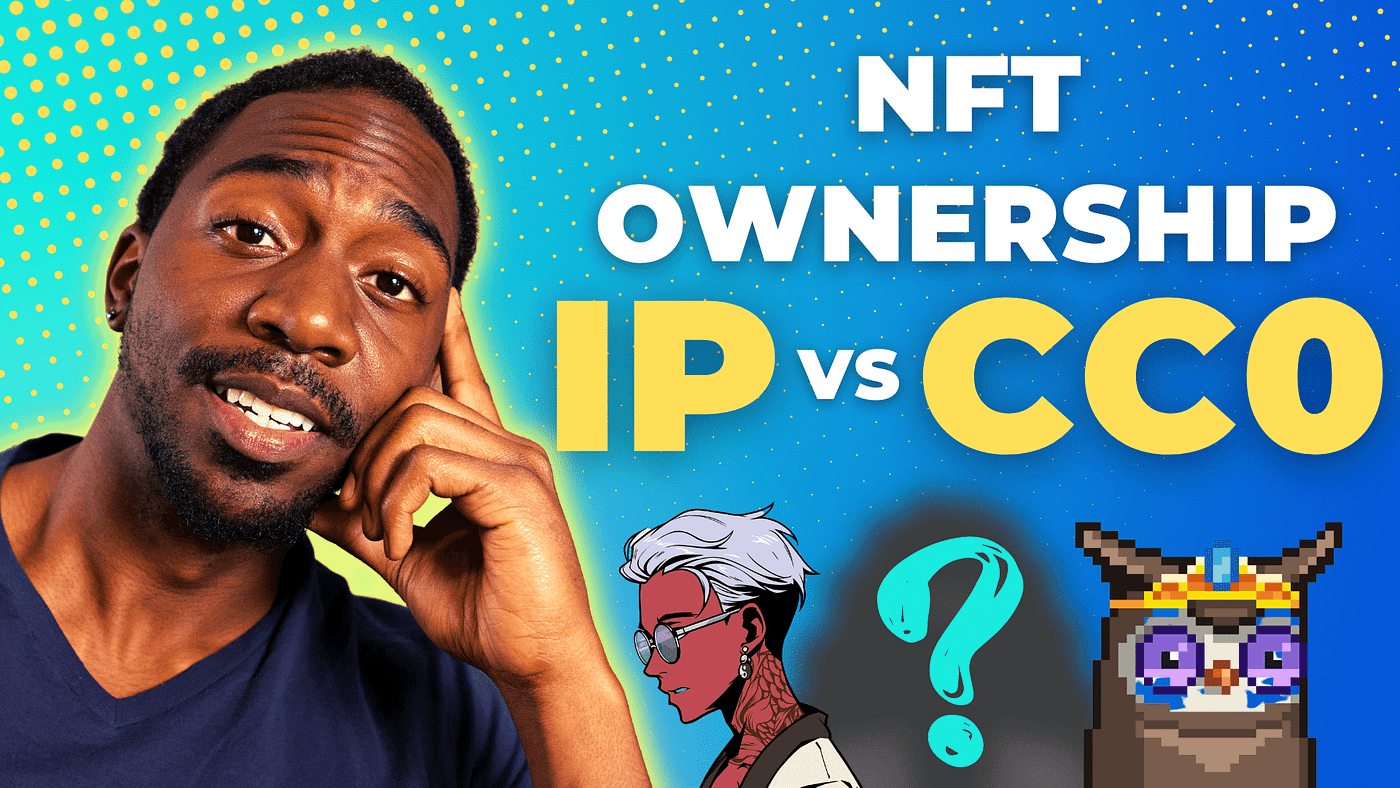
Ready to Learn + Grow?
Subscribe On YouTube 🎥 Official Native Assets YouTube
Follow on Twitter 🐦 Official Twitter
Listen To The Podcast 🎙 Official Podcast
Buy The Book 📖 The Blockchain Blueprint
Mirror ✏️ Official Native Assets Mirror (Decentralized Blog)
Discord 👻 Official Native Assets Discord
Book A Consultation 🎖 calendly.com/nativeassets/one-hour-consultation-with-native-assets